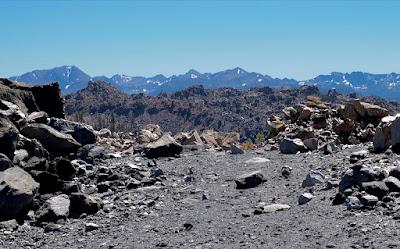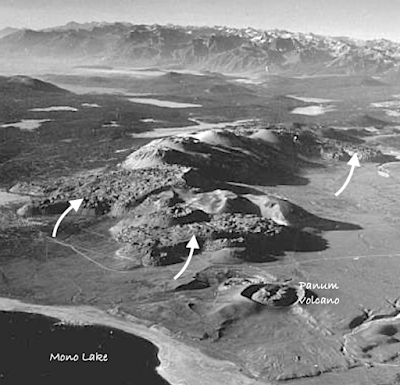View south from top of Obsidian Dome; Glass Creek Dome mid photo, Sierra Nevada on skyline.
After touring the Mono Craters, accompanied by the spirit of pioneering geologist Israel Russell, I drove south on US 395 to see more of eastern California's volcanics. This time I was led by Robert P. Sharp and Allen F. Glazner, authors of Geology Underfoot in Death Valley and Owens Valley (1997, first edition).I was intent on visiting a rhyolite dome or coulée (lava flow), landforms that had puzzled Russell during his fieldwork in the Mono Basin in 1883. "These outbursts of acidic lava are in strong contrast with the overflows of basic rock with which geologists are most familiar ... [which] are frequently quite liquid at first, flow rapidly, and reach a distance of many miles before congealing sufficiently to check their progress." Not so the Mono coulées. They barely reached beyond the foot of their cones.
Mono Craters, added arrows point to coulées—short thick lava flows with rugged surfaces and steep sides (from USGS 1971).
Russell rightly concluded the lava had been extremely viscous and therefore flowed very slowly. He considered these coulées unusual, perhaps unique. Surely geologists would be eager to study them. "When the valley in which these craters are situated becomes more familiar to tourists and geologists, they can not fail to be widely known as typical illustrations of mountains formed of acidic lavas." And so it came to pass.Time has proven Russell wrong in thinking the Mono coulées unique; similar flows have been found around the world. But he was spot on about geological interest. Rhyolite volcanoes are relatively uncommon, so their abundance in eastern California makes the area attractive to volcanologists. Especially intriguing is their youth. Most erupted in the last 10,000 years, several in the last thousand. And they may be only sleeping.
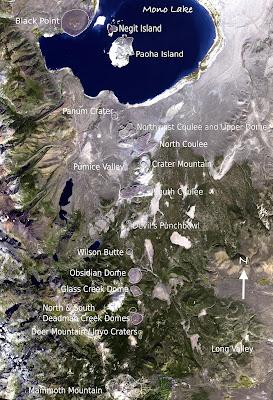
Between Mammoth Mountain and Mono Lake "virtually every hill is a young volcano" (Sharp & Glazner 1997; NASA photo 2000).
Rhyolite domes and coulées are not easy to examine, as Russell explained. "The extreme ruggedness of the coulées is due to the fact that they hardened at the surface during the time they were still moving. The crust thus formed became broken and involved in the pasty material beneath in a most complicated manner. ... Even at the present day, after many blocks have fallen and the formation of a talus slope has commenced, the climber finds it extremely difficult to scale these rugged and broken escarpments of glassy fragments."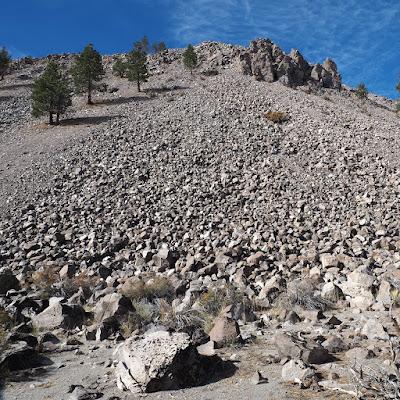
Flow front, North Coulée, Mono Craters.
However not far from Mono Craters is a dome that can be scaled without difficulty. On the west side of Obsidian Dome a road ascends the rugged broken escarpment to the top. A locked gate limits access to all but foot traffic.The Obsidian Dome volcano erupted in 1350, just 633.5 years ago (associated tree mortality occurred in late summer of that year). Lava slowly oozed from the vent and flowed outward, forming what looks like a giant cowpie 1–2 km across and 50–100 m thick, its surface rough with jumbled blocks of volcanic rock. Aside from its shape, Obsidian Dome is similar to the Mono Crater coulées that Russell found so striking with their steep sides and rough surfaces. "Obsidian Coulée" is actually more appropriate.
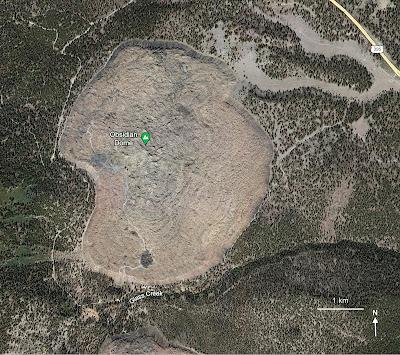
Obsidian Dome, the cowpie coulée. Google Earth 2019.
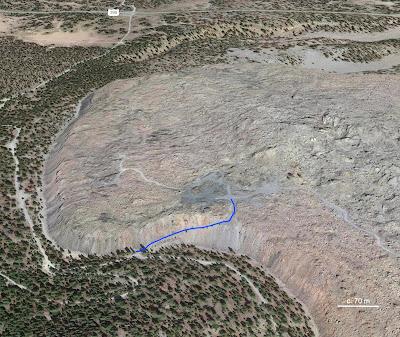
Looking ± northeast at Obsidian Dome; blue line is gated access road. Gray area is an old pumice quarry, the reason for the road. Google Earth 2019.
Obsidian Dome and its road are featured in the geological vignette "Ominous Ooze" in the first edition of Sharp and Glazner's guide. I like the first edition very much. It provides more detail in descriptions and discussions, for example nine pages are devoted to Obsidian Dome vs. only three in the second edition. I found it especially helpful in appreciating the varied and beautiful rocks on display—all rhyolite and yet so different!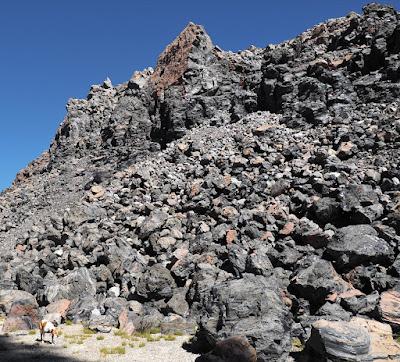
Formidable slope of broken glass, slightly worried field assistant for scale.
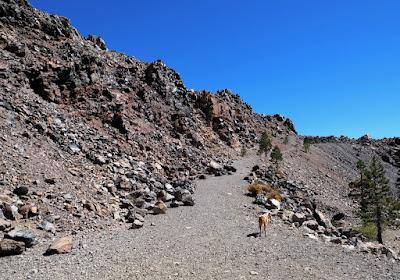
But the ascent turned out to be a stroll :)
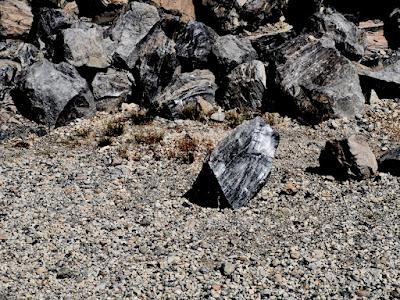
Chunks of black glass were beautiful to the eye but challenging for the camera's light meter.
"Glass" and "glassy" often appear in descriptions of rhyolite volcanoes. Accustomed as we are to the transparent stuff, this can be confusing. Broadly speaking a glass is a non-crystalline solid that cooled so quickly from a liquid state that crystallization was impossible. A myth persists that glass is actually a super viscous liquid that flows at the scale of centuries (for example in old window panes). This has been discounted. But the transition of glass from liquid to solid remains an unsolved problem in physics.Whatever the exact nature of glass, the volcanoes that extruded these domes and coulées were well equipped to produce it. The magma was >70% silica; at such a high concentration silica tetrahedra (molecules) bind tightly to each other, making super viscous lava. Not only did it barely flow, it was so viscous that other kinds of atoms couldn't move around and bond with their brethren to form crystals. When crystal-poor lava such as this cools rapidly, for example by being carried to the surface in a volcanic eruption, obsidian and other forms of volcanic glass result.

The tiny silica tetrahedron plays a big role in volcanoes (source).
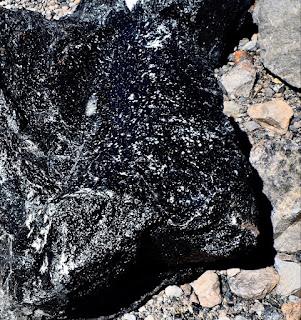
Obsidian with scattered small crystals in a matrix of glass.
At the base of the coulée and along the road to the top I saw lots of obsidian with bands of pale pumice—also a glass but filled with bubbles. Perhaps it formed from frothy lava during a more explosive phase. These rocks were especially beautiful with their varied combinations of banding, curves, and swirls.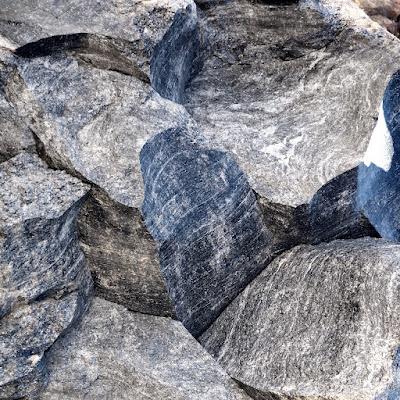
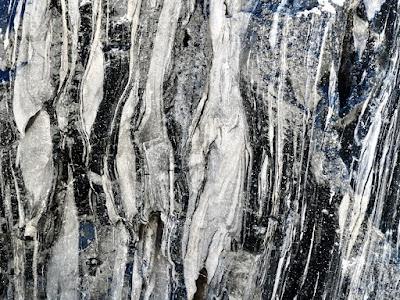
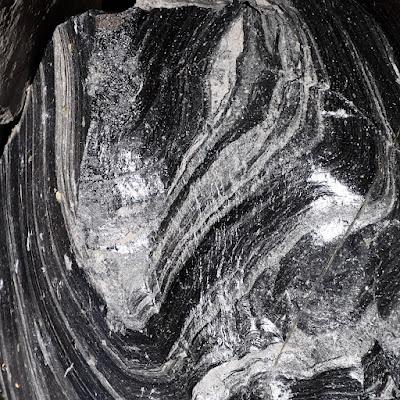

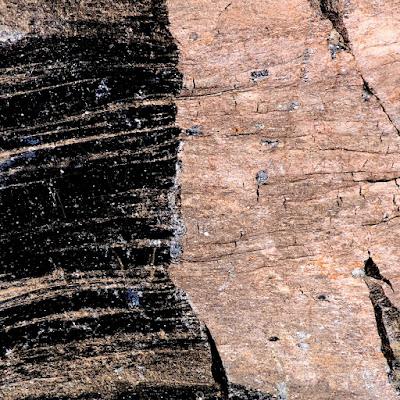
What happened here?!
Amid the shiny black broken glass, and sometimes bonded to it, was dull pinkish orange and gray rock that seemed out of place. It turned out to be one of the more interesting finds of the day—stony rhyolite, which has the same chemical composition as obsidian but is crystalline. Even more intriguing, given enough time obsidian will become stony rhyolite.Those atoms that initially were stymied in their attempts at crystal formation don't give up! It may take a million years but eventually they find a way through the silica tetrahedra, meet their brethren, form crystals, and convert the non-crystalline obsidian to stony rhyolite.
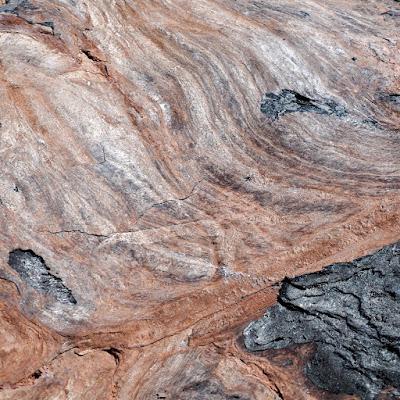
Stony rhyolite can be as beautiful as obsidian.
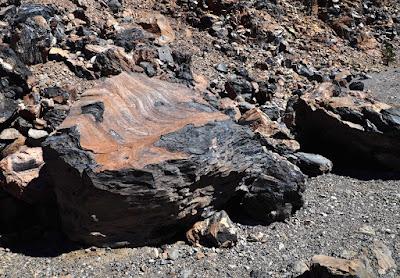
The hike wasn't long, but there was so much to see! Finally we reached the top. The landscapes were surreal.
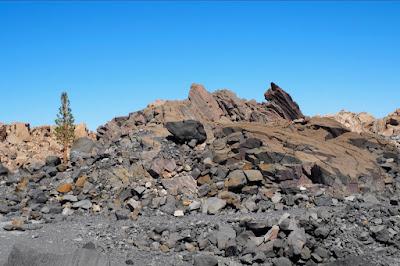

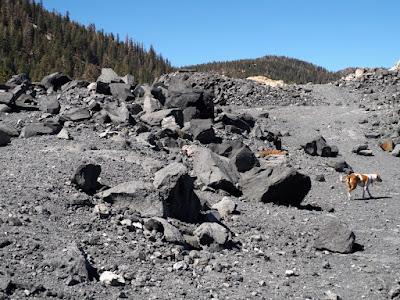
Coarsely vesicular obsidian, part of a squeeze-up (read more here).
Sharp and Glazner end their vignette with the difficult but unavoidable question—why are these volcanoes here? Volcanologists have made some progress in answering it. They've even drilled deep into Obsidian Dome, thanks to the road to the old pumice quarry. But that's the subject of a future post, after our next visit.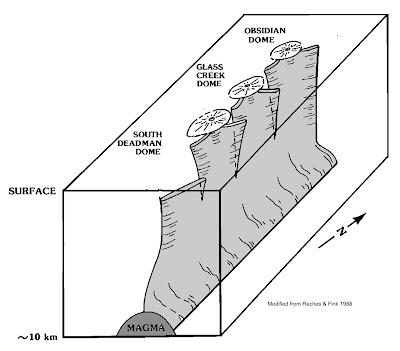
The Inyo Dike, suspected source of Obsidian Dome and its neighbors (Reches & Fink 1988).
Sources
Fisher, RV, Heiken, G, Hulen, JB. 1997. Volcanoes: crucibles of change. Princeton U Press.
Reches, Z., and Fink, J.H., 1988, The mechanism of intrusion of the Inyo dike, Long Valley caldera, California: J. Geoph. Res. 93:4321–4334. https://doi.org/10.1029/JB093iB05p04321
Russell, IC. 1889. Quaternary History of Mono Valley, California in USGS 8th annual report (If the USGS PDF is slow to load and read online, try HathiTrust.) Russell's report was printed separately in 1984 by Artemisia Press, Lee Vining, CA (out of print).
Sharp, RP, and Glazner, AF. 1997 (4th printing 2003). Geology Underfoot in Death Valley and Owens Valley. Mountain Press. NOTE: A revised second edition was published in 2022 (Glazner, Sylvester, & Sharp). Based on the areas I've visited, it seems more science light. But of course maps and illustrations are far better. Perhaps buy both.
Vogel, TA, et al. 1989. Petrology and emplacement dynamics of intrusive and extrusive rhyolites of Obsidian Dome, Inyo craters volcanic chain, eastern California: J. Geoph. Res. 94:17,937–17,956. PDF (Open Access)
